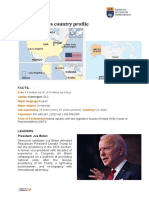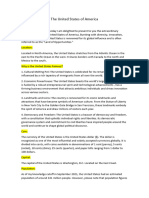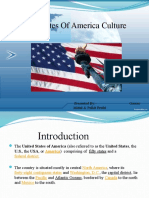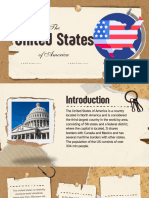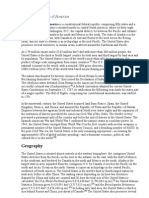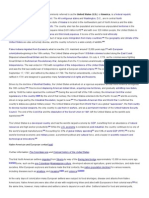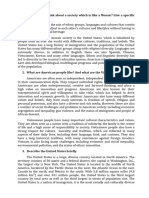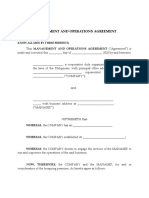Name: Marlyn T.
Orticio Date: 03-24-23
Course/Year/Section: GBA-1E
The United States of America U.S.A. or USA, commonly known as the United States (U.S. or US)
or America, is a country primarily located in North America. It consists of 50 states, a federal district, five
major unincorporated territories, nine Minor Outlying Islands,[h] and 326 Indian reservations. The United
States is also in free association with three Pacific Island sovereign states: the Federated States of
Micronesia, the Marshall Islands, and the Republic of Palau. It is the world's third-largest country by both
land and total area.[b] It shares land borders with Canada to its north and with Mexico to its south and
has maritime borders with the Bahamas, Cuba, Russia, and other nations.[i] With a population of over 333
million,[j] it is the most populous country in the Americas and the third most populous in the world. The
national capital of the United States is Washington, D.C. and its most populous city and principal financial
center is New York City.
Paleo-Americans migrated from Siberia to the North American mainland at least 12,000 years ago, and
are the ancestors of modern Native Americans. Colonization by Europeans began in the 16th
century. Great Britain's Thirteen Colonies, in what is now the eastern U.S., quarreled with the British
Crown over taxation and political representation, leading to the American Revolution (1765–1791). After
the Revolution, the United States gained independence, the first nation-state founded
on Enlightenment principles of liberal democracy. In the late 18th century, the U.S. began expanding
across North America, gradually obtaining new territories, sometimes through war, frequently displacing
Native Americans, and admitting new states. By 1848, the United States spanned the continent from east
to west. The controversy surrounding the practice of slavery culminated in the secession of
the Confederate States of America, which fought the remaining states of the Union during the American
Civil War (1861–1865). With the Union's victory and preservation, slavery was abolished by the Thirteenth
Amendment.
America is home to people from all around the world, so when you study at a US university, you’ll likely
encounter unique cultures, traditions, arts, sports, and more. Over time, these many multicultural
traditions have blended and adapted to become the face of culture in the USA. The different cultures and
groups of people that have immigrated to the U.S. over the years have made many important
contributions to the development of this country. For example, the Chinese, German, Irish, and
Scandinavian immigrant groups made great contributions to the development of the western United
States. These groups, particularly the Chinese, provided much of the labor that built the railroads that
connected the Eastern and Western portions of the United States. Additionally, these immigrant groups
provided large amounts of labor during the Industrial Revolution. Without the contributions of these
immigrant groups, America would not be what it is today.
Cultural diversity in the U.S. has created a melting pot. A melting pot refers to a society or community
where different cultures, religions, races, traditions, and languages are present. Sometimes, the different
cultures that are present in the U.S. have blended to form a new, district culture. For example, Louisiana
Creole is a culture that is a combination of French, English, Spanish, African, and Native American
cultures. Louisiana Creole has its own language, traditions, and cuisine.
Every country has its own set of values and principles, and this is also true for America. Speaking
generally, people in the USA align with the values stated in our Declaration of Independence: that all are
created equal, with unalienable rights of life, liberty, and the pursuit of happiness. Let’s take a closer look
�at what this means from a cultural values perspective.From a young age, Americans are taught to be self-
sufficient and independent. The importance of a person being able to mold their own identity and future
via their own choices, abilities, and efforts is heavily emphasized in American culture, education, and
institutions. Americans value taking care of themselves and having the freedom to pursue their own
definition of happiness. This extends to university life, where students are in charge of selecting their own
major and pursuing the degree program that best aligns with their personal goals. For international
students who come from a culture where everything is done collectively as one unit/family, this emphasis
on individualism and autonomy could take some getting used to. Focusing on independence does not
mean you are alone, however, as there are many communities, advisors, and support services in the US
you can rely on in times of need.For Americans, equality means everyone is born equal and no one is
inferior or superior to the other. US universities take equality seriously, and will often include statements
affirming equal rights in their charter, annual reports, and student and staff codes of conduct.
Additionally, anti-discrimination policies are often in place and enforced for admissions, hiring, events,
etc. If you attend a US university, you can expect to live and study in an equitable and inclusive campus
environment, where everyone can learn and freely pursue their goals.
Canada, the United States and Mexico have long collaborated as continental partners in the world’s most
prosperous region. The North America region has a combined population of almost 530 million and an
economy that represents more than one-quarter of the world’s GDP. The three countries are amongst
each other’s largest trading partners and sources of foreign investment. The continent’s abundant natural
resources and integrated continental energy markets provide important economic and security benefits
for our citizens.
The North American economy has developed as an integrated production platform, which maximizes our
capabilities and makes our economies more innovative and competitive. While the majority of Canada’s
trade is with the United States, trade and investment with Mexico is growing – both directly and
indirectly – as part of regional/continental supply chains, which has opened new global export
opportunities for Canadian small and medium-sized enterprises. In 2015, North American trilateral
merchandise trade amounted to US$1.0 trillion. Our combined GDP has more than doubled over the past
two decades, rising from US$8.0 trillion (in 1993) to $US20.6 trillion today. North American economic
integration has also encouraged a steady increase in investment among all three countries. For example,
in 2015, Canadian companies invested over C$463 billion into the U.S. and Mexico.
The emergence of new economic powers and trading regions, and the resulting increased global
competition, is transforming the dynamics of the global economy and posing new challenges to North
America’s future prosperity. Given geographic proximity, all three countries face common issues relating
to environmental sustainability, natural disasters and pandemics. Moreover, our shared land borders
bring common security risks, such as the flow of illicit drugs, transnational crime and terrorism.
Close collaboration between the governments of Canada, the United States and Mexico is critical to
addressing these broader economic, security and environmental challenges. This collaboration rests on
shared democratic values, respect for the rule of law and free market principles. Beyond the North
American continent, the three countries work together to advance prosperity and security throughout
the region and the world. We collaborate together within the Organization of American States, at the
�Summit of the Americas and at the G20, with the aim of strengthening the effectiveness of these
international bodies to address pressing global challenges.
American retailers are pushing hard to extend their reach across the border – especially those that see
international expansion as an opportunity for growth. Canada has been seen as a natural transition for
American retailers, who view it as an easier market to enter due to a common language and Canadian
consumers’ familiarity with American brands from cross-border shopping, TV and advertising. Canadians
and Americans are alike and the exact opposite at the same time.
Americans are generally more sociable, patriotic, conservative, religious, and traditional. Canadians are
more restrained and at the same time more liberal. Canadian consumers are notably more pessimistic
than their global peers in their expectations for spending in the next six months. Canadian respondents
are significantly less likely than average, in many categories, to expect increases in spending. Americans
are usually very open minded. America people tend to want to be independent and be responsible for
their own actions.
However, the now infamous Target Canada fiasco has provided a much needed reminder that new
entrants must be sophisticated when it comes to their Canadian expansion strategy. A critical factor in
successful market entry is not underestimating the Canadian consumer, who is most likely familiar with
the company’s American brand standards and pricing. Despite their surface-level commonalities,
Canadian and American consumers are incredibly different and retailers must understand the nuances
between them in order to successfully cross the border. For instance, one of the many cultural differences
is in how Canadians consume advertising and marketing. There is an incredibly low transferability rate
between ads that were created in the American and then exported to Canada without any alteration. In
one study, 60% of effective American ads resulted in much lower sales effectiveness in Canada. This small
example is only in regard to advertising and marketing and does not account for the greater totality of
consumer shopping patterns. Ultimately, American retailers need to understand whether they can adapt
their merchandising, marketing and store operations to achieve maximum effectiveness and efficiency
based on a solid awareness of the buying habits of Canadian consumers.
















